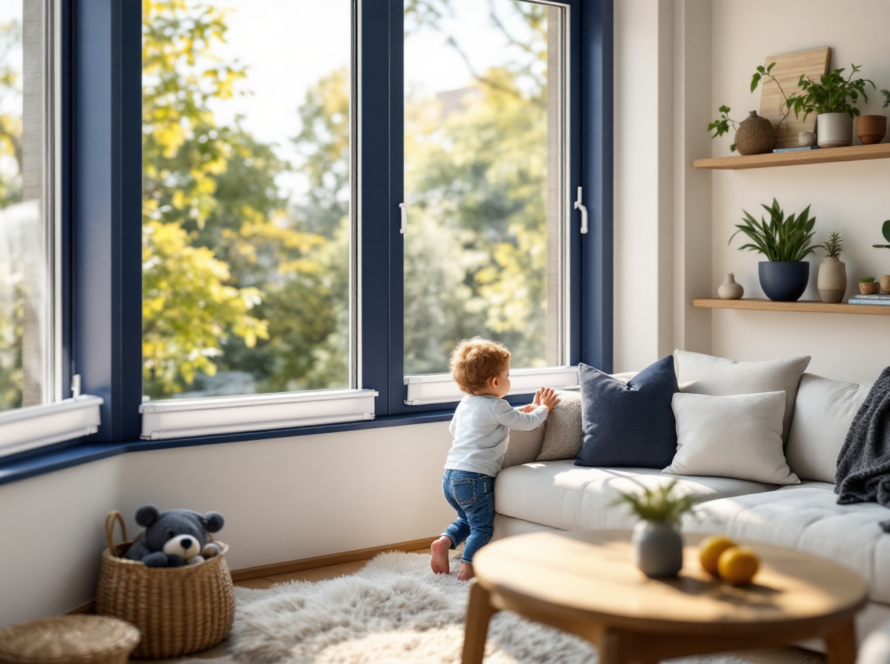When thinking about ways to reduce your home’s carbon footprint, windows might not be the first thing that comes to mind. However, they play a critical role in your home’s energy efficiency and sustainability. The right windows can lower your energy consumption, reduce greenhouse gas emissions, and contribute to a healthier planet—all while keeping your home comfortable and stylish.
In this guide, we’ll explore how windows reducing your home’s carbon footprint can make a big difference and how you can choose sustainable options that benefit both your wallet and the environment.
TLDR – Quick Guide
- Seal the deal: Drafty windows waste energy; sealing them is an easy first step.
- Go energy-efficient: Upgrade to Low-E glass and multi-pane windows for optimal insulation.
- Maximize natural light: Reduce artificial lighting needs by choosing windows that let in more sunlight.
- Eco-friendly materials: Opt for frames made from sustainable or recycled materials.
- Maintenance matters: Regular upkeep keeps windows efficient and extends their lifespan.
Detailed Breakdown
1. The Connection Between Windows and Energy Consumption
Windows are a major factor in your home’s energy use. Poorly insulated or outdated windows allow heat to escape in winter and enter in summer, forcing your HVAC system to work harder. This excess energy usage contributes directly to carbon emissions.
Key Stats:
- 30% of residential heating and cooling energy is lost through windows, according to the U.S. Department of Energy.
- Homes with energy-efficient windows can reduce greenhouse gas emissions by 12%-20% annually.
2. How Windows Reduce Your Carbon Footprint
Energy Savings
Upgrading to energy-efficient windows lowers your reliance on heating and cooling systems, which are significant contributors to carbon emissions. Look for ENERGY STAR-certified windows to ensure maximum efficiency.
Natural Light
Windows that optimize natural light reduce your dependency on artificial lighting, further cutting electricity use. Installing larger or strategically placed windows can brighten your home while saving energy.
Sustainable Materials
Eco-friendly window frames made from recycled aluminum, sustainably sourced wood, or fiberglass are more environmentally friendly than traditional options. These materials have a lower carbon footprint during production and are often more durable.
3. Choosing the Right Windows
When upgrading windows, prioritize features that enhance both efficiency and sustainability:
- Low-E Glass: Reflects heat while allowing sunlight in, reducing energy use year-round.
- Double or Triple Panes: Minimize heat transfer, especially in extreme climates.
- Gas Fills: Argon or krypton gas between panes adds an extra layer of insulation.
- Recycled Frames: Choose frames made from eco-conscious materials for a smaller production footprint.
4. DIY Tips for Eco-Friendly Window Maintenance
You don’t have to replace all your windows to start reducing your carbon footprint. Here are some easy maintenance tips:
- Seal leaks: Use weatherstripping or caulk to close gaps and prevent drafts.
- Install window films: Add a UV-blocking film to reduce heat gain during summer.
- Use curtains or shades strategically: Heavy curtains in winter and reflective blinds in summer can boost efficiency.
5. Long-Term Benefits of Green Windows
Beyond energy savings, windows that contribute to a smaller carbon footprint can improve your quality of life:
- Lower utility bills: The less energy you use, the less you pay.
- Increased property value: Sustainable upgrades appeal to environmentally conscious buyers.
- Improved indoor air quality: Better-insulated windows prevent outdoor pollutants from entering your home.
Key Takeaways
- Seal and upgrade: Fix drafts and consider energy-efficient windows to slash energy waste.
- Natural light advantage: Let the sun shine in to cut back on artificial lighting needs.
- Eco-materials: Choose sustainable window frames for an even greener impact.
- Maintenance is key: Proper upkeep extends the life of your windows and their eco-benefits.
- Bigger picture: Small changes to your windows can lead to significant reductions in your home’s carbon footprint.
Reducing your carbon footprint starts with smart decisions at home. Investing in windows that minimize energy loss and maximize sustainability is a win for both your household and the planet.
FAQs
1. How do windows contribute to a home’s carbon footprint?
Windows that aren’t properly insulated let heat escape in winter and enter in summer, increasing the energy required to regulate indoor temperatures. This leads to higher energy consumption and carbon emissions.
2. What features should I look for in energy-efficient windows?
Prioritize Low-E coatings, double or triple panes, gas fills, and frames made from eco-friendly materials like recycled aluminum or sustainably sourced wood.
3. Can I improve my existing windows without replacing them?
Yes! Sealing leaks, applying window films, and using energy-efficient curtains or blinds can improve insulation and reduce energy waste.
4. Do energy-efficient windows really make a big difference?
Absolutely. ENERGY STAR-certified windows can save you up to 30% on heating and cooling costs annually while significantly reducing your home’s carbon footprint.
5. Are there incentives for upgrading to eco-friendly windows?
Many governments and utility companies offer rebates or tax credits for installing energy-efficient windows. Check local programs to offset costs.


